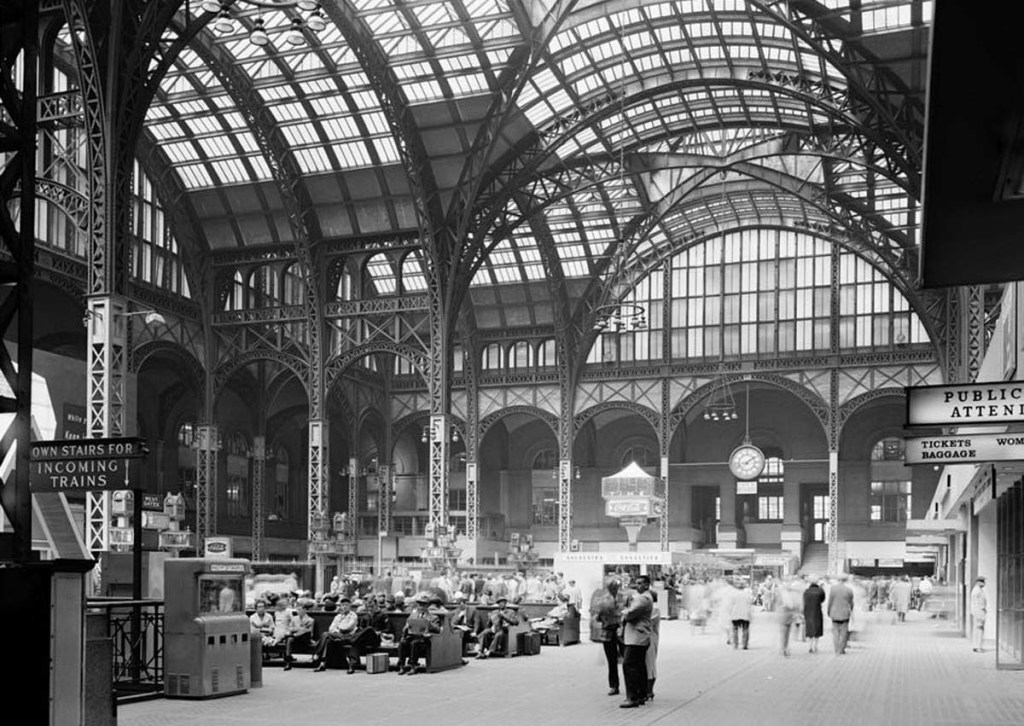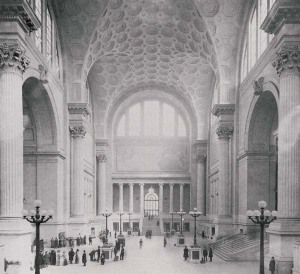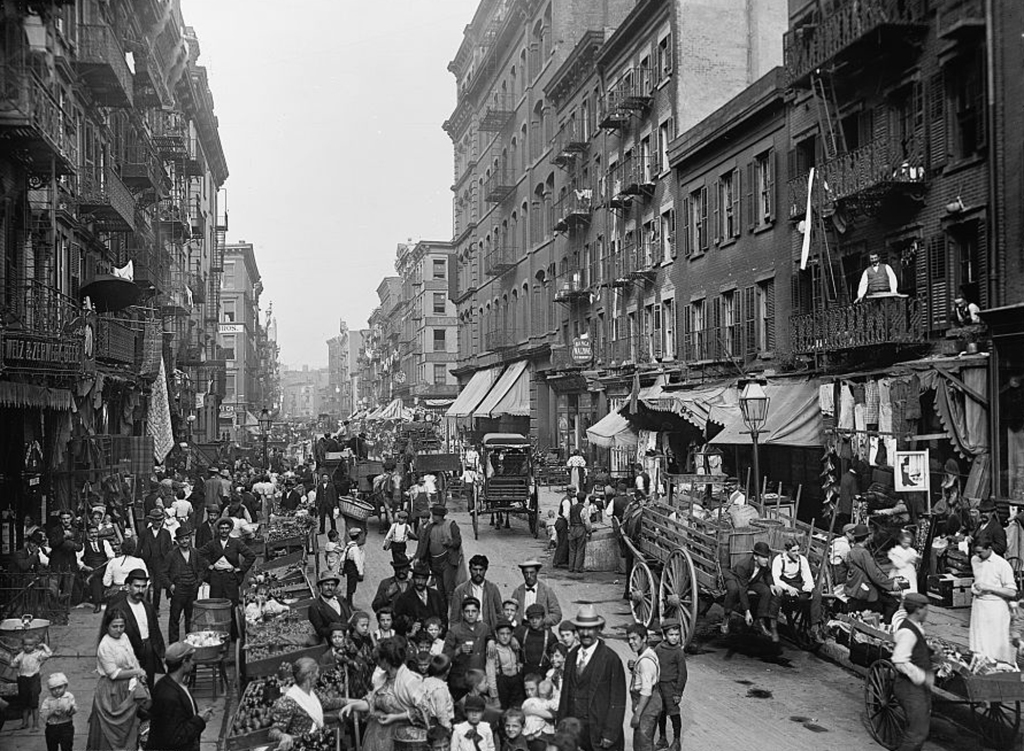I realized this was a good idea the previous day when Gwenna and I were walking around Midtown and I asked if we could detour to see inside the Penn Station train terminal, because I wanted “to see if it was really as bad as they say it is.” As I said it, even I could sense how weird that request sounded, so I dropped the idea and we continued on in search of good pizza.
 Weeks before, I had seen a documentary that described in detail how the first Penn Station had been created just over a hundred years ago. It was a beautiful, lofty terminal filled with light and huge arched ceilings that matched the rhythms and grandeur of old Rome. Then, just half a century later, they decided to demolish it. Yep, someone decided to tear down one of the nicest buildings ever. Everything except for the train track concourse at the lowest level was jackhammered into oblivion. Then they built a claustrophobic version of a train station with the Madison Square Garden sports arena above it.
Weeks before, I had seen a documentary that described in detail how the first Penn Station had been created just over a hundred years ago. It was a beautiful, lofty terminal filled with light and huge arched ceilings that matched the rhythms and grandeur of old Rome. Then, just half a century later, they decided to demolish it. Yep, someone decided to tear down one of the nicest buildings ever. Everything except for the train track concourse at the lowest level was jackhammered into oblivion. Then they built a claustrophobic version of a train station with the Madison Square Garden sports arena above it.
The saga began in the early 1900s when Alexander Cassat, president of the Pennsylvania Railroad, noticed how much he hated that his company’s trains didn’t actually arrive in New York, but instead stopped on the New Jersey side of the Hudson River, requiring passengers to scramble for a fleet of ferries to make it the rest of the way to Manhattan. So he quietly set about buying up the tenements in an entire two-block area on the West Side of Manhattan while his team of engineers and diggers began to tunnel through the thick sludge under the Hudson River, the first time such a feat was ever attempted. Cassat hired a leading architect of that era, Charles McKim, to design the train station. McKim and Cassat fed off each other’s enthusiasm, and the end result was a masterpiece of Beaux Arts magnificence, modeled on the massive Roman Baths of Caracalla with a bit of Paris’s newest train station, Gare D’Orsay, thrown in as an influence.
It was a beautiful building, one for the ages. Unfortunately, robust patronage of train travel was not for the ages. As more and more passengers turned to automobiles in the 1950s, the finances of Pennsylvania Railroad suffered and the decision was made to sell the development rights above the station, so it was demolished in 1963 to make way for Madison Square Garden and an office building. The train concourse below was kept in place and a new, dumpy 1960s version of a train station was made to fit between the tracks below and the arena above.
The documentary that I saw about all this (“The Rise and Fall of Penn Station” available for viewing on YouTube) included footage of workers matter-of-factly jackhammering beautiful granite plinths into rubble. It’s appalling to watch that, just as it appalled New Yorkers to see one of their finest buildings turned to ruins; they realized too late that they had not done enough to try to save it. Never again would this sort of thing happen in New York. Penn Station became the martyr that let other notable buildings live.
“Where we once entered like kings, we exit like rats,” wrote architectural historian Vincent Scully about the new Penn Station. That’s why I wanted to see it, so I could get in on the story. Was it really all that bad?Indeed, I found it to be a dumpy 1960s version of a train station — utilitarian at best. Rome was gone. In its place were ceilings and escalators and fluorescent lights that felt sort of like being in a JCPenney, except darker.
These days train travel is once more on the rise and there is talk about redoing Madison Square Garden and relocating Penn Station into the grand neoclassical post office right across the street. I’ll keep track of that in case it gets interesting.
From there I walked over to Grand Central Station (site of many a viral video of flash mobs breaking out in surprise performances) to remember what an impressive train station felt like. Then it was up Park Avenue for a brief visit to the lobby of the Waldorf Astoria Hotel. Nothing remarkable to report there.
I made sure to seek out Paley Park, a delightful little plaza with trees between two buildings on 53rd Street that has been a favorite of mine since I saw a short film that discussed it years ago in school. It’s only 42 feet wide and 100 feet deep, but has a full-width waterfall at the back. The sound of the rushing water softens the city noises, the grid of trees makes for good dappled shade, and all the chairs are movable to allow people to arrange their own sitting choices. These factors somehow combine to make this little park a wonderful place to briefly leave the city behind. The people watching is good, and that in turn draws more visitors, making the people watching even better.
I know about the synergistic aspects of this park because of a film by William Whyte, a sensitive man with a droll sense of humor and great insights as to how humans really use urban spaces. His one-hour film is called “The Social Life of Small Urban Spaces,” and it too can be seen on YouTube. He has a book by the same name that is an easy read.
In the 1960s Whyte became an adviser to the New York Planning Commission because of his skill in collecting useful data on how to create truly user-friendly plazas and small parks. Through endless months of charting where people actually hung out in existing plazas (and with time-lapse photography) he obtained measurable information on how people really use these sorts of spaces, sometimes in direct contrast to conventional wisdom. This led to the creation of very specific zoning guidelines, such as how to best include ledges for sitting and why it’s best to plant trees in groves. Whyte’s work led to people-friendly plazas and parks throughout New York. Job well done, I say.
Perhaps my biggest plunge into being a tourist came when I decided to spend a couple hours on one of those “hop on, hop off” double-decker buses with the top level open to the city. There could be nothing more touristy that this. I decided not to care — an attitude I found very liberating. I chose to see this as a way to effortlessly be toured about the interesting parts of Manhattan in an elevated convertible. What’s not to like about that?
The bus crept through the traffic of the Theater District, then slowly through Greenwich Village, where we actually had to duck our heads under overhanging branches. Dangerous, sure, but I saw it as added adventure. After that it was down Fifth Avenue past the famous “Flatiron” building of 1902 on its narrow triangular lot. The slender tapered building was quite tall for its era. Some of the locals were sure it would topple in a strong wind. It didn’t.
When my bus got to Little Italy, I used my “hop off” privilege to better explore the area on foot. I was on a mission to see Mulberry Street because of an image I had seen two days before in a coffee-table book at my daughter’s apartment called “New York — Then and Now.” It showed that street as it was a hundred years ago when it overflowed with Italian culture.
Mulberry Street had been the cultural heart of Little Italy. Think of those great scenes in the second “Godfather” movie of the bustling and boisterous street life in that immigrant community. Italian Americans have since spread out across America from there. These days the Italian restaurants are moving out of Little Italy because of high rent. Chinatown is creeping in, so the bustle of Little Italy I was hoping to see was just about gone.
But I had also come to see the staggered rooftops and jumbled fire escapes, just like where a young Robert DeNiro as Vito Corleone hopped from roof to roof to dump pieces of his gun down various stovepipes after he rid the neighborhood of that mean old Don Fanucci.I got a call from Gwenna, who seemed bored and anxious for us to meet up again, this time at the Metropolitan Museum of Art for a couple hours of world-class art. So I used my nascent subway skills to head uptown. Before taking off for California the next morning, I bought her a one-month subway pass so she would be free to travel at will and not worry about scrimping and altering her errands to save on subway fare. A dad’s got to do something to help out his little girl before he leaves her alone in such a big city!
Read part one of Steve’s New York adventure by CLICKING HERE.
Steve McKee is a Benicia architect specializing in residential design. He can be reached on the Web at www.smckee.com or at 707-746-6788.










Steve:
Thanks for all you do to keep the species alive, bright, and charming. Some of us are apathetic or greedy clods, obstructionists, useless Congress members and dysfunctional Supreme Court members. No wonder the First Flood washed away most of our First Draft if that myth is to be believed.
Peter Bray, Benicia, CA
Peter stated:dysfunctional Supreme Court members.
We are on the same page on that one (though I do not see how your comments are related to Steve’s excellent piece). Yes indeed there is at least one SCJ who
defines dysfunctional.
DDL:
Finally we agree on something. Steve is bright and always informational. I was just expanding my view to include some worthless scumbags on the human horizon in contrast to my value of his glowing lightbulb in the ceiling. Everything is relative under the integral curve.– pb
I was just expanding my view to include some worthless scumbags on the human horizon
Kind of harsh words to describe Ginsberg.
The net effect on the public is the same whether I call them puppies, pawns, or angels of Corporate America… Call them clear blue water if you like…pb
Your piece on Manhattan evoked many memories of the Big Apple. Thanks for the guided tour through word pictures.
I love N Y City and also the new Penn Station. Did not see the old. When living in Baltimore my wife and I could take the train to NYC and walk to our hotel. Great area.. I do like Grand Central Station. But I do miss the St. Moritz hotel now a Ritz Carlton. My wife and I would get a suite on our travels from San Francico to NYC. Great area. I have been all over NYC and love it. Great article about a great city.
Steve,
Good piece, I enjoyed it very much.
I am pretty sure if you look closely at the picture of Mulberry Street, the guy on the right (white shirt and bow tie, sitting on the back of the wagon) is Vito Corleone and next to him is Clemenza.
😉